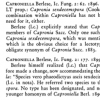
16-10-2011 03:52
 Chris Yeates
Chris Yeates
Collected on a dead attached rachis of Dryopteris

18-10-2011 07:41
Reza ShaianThis Gyromitra collected last week from Iranian No

17-10-2011 09:10
 Peter Welt
Peter Welt
Dennis,R.W.G. (1974) – New or interesting Britis

13-10-2011 09:44
 Björn Wergen
Björn Wergen
Hello again,this finding seems to be an inopercula

09-10-2011 23:29
 Stip Helleman
Stip Helleman
Bonjour à tous,Has anyone heard or know about a A

10-10-2011 16:45
 Jacques Fournier
Jacques Fournier
Bonjour,j'ai été attiré par ce disco qui sur le

04-10-2011 13:16
 Yannick Mourgues
Yannick Mourgues
Bonjour à tous.Avez-vous connaissances d'autres a

06-10-2011 22:05
 Yannick Mourgues
Yannick Mourgues
Bonsoir à tous.Première interrogation parmi tout
Caproniella
Gernot Friebes,
21-10-2011 18:04
I have a question about the name Caproniella Berl. All sources I know say that it was published in Icones Fungorum II: 62 but Caproniella is mentioned there only as a note under the description of Capronia (http://imgbase-scd-ulp.u-strasbg.fr/displayimage.php?album=376&pos=66). This can't be enough for introducing a new name officially, can it? Especially since the following two species aren't transferred to Caproniella (both Index Fungorum and MycoBank list "Caproniella pleiospora (Mouton) Berl., Icon. fung. (Abellini) 2: 62 (1896)" respectively "Caproniella pleiospora (Mouton) Berl. 1896, Icones Fungorum. Pyrenomycetes 2: 62" so, according to them, C. pleiospora should have been transferred to Caproniella on page 62, which I linked above).
To me it is unclear when and where the name Caproniella was published originally and when the species C. juniperi and C. pleiospora were transferred to Caproniella. It would be great if somebody could help me with this problem!
Best wishes,
Gernot
Martin Bemmann,
21-10-2011 18:23

Re : Caproniella
Hi Gernot,
a clearer separation from Capronia you will find in the footnote on page 177 of the same work (16 spores...).
http://imgbase-scd-ulp.u-strasbg.fr/displayimage.php?album=376&pos=181?
Best regards,
Martin
a clearer separation from Capronia you will find in the footnote on page 177 of the same work (16 spores...).
http://imgbase-scd-ulp.u-strasbg.fr/displayimage.php?album=376&pos=181?
Best regards,
Martin
Gernot Friebes,
21-10-2011 18:35
Re : Caproniella
thank you, Martin! I have seen this footnote too but then I wonder why Berlese lists C. juniperi and C. pleiospora in the genus Capronia on page 62 f. It makes it even more mysterious to me that according to Index Fungorum and MycoBank C. juniperi has already been transferred to Caproniella in 1876. However, there is no further literature given...
Best wishes,
Gernot
Best wishes,
Gernot
Guy Garcia,
21-10-2011 18:54
Re : Caproniella
Salut Gernot,
Voir page 177 du volume 2 (texte)
Voir page 177 du volume 2 (texte)
Gernot Friebes,
21-10-2011 19:15
Re : Caproniella
Hi Guy,
merci! Also Martin pointed out page 177 but it remains unclear to me why the literature always referres to page 62. Wouldn't "Caproniella Berl., Icones Fungorum II: 177 (1900)" be correct then?
By the way, it's incorrect that C. juniperi was transferred to Caproniella already in 1876 (as given in Index Fungorum and MycoBank) since this species wasn't described until 1887.
Best wishes,
Gernot
merci! Also Martin pointed out page 177 but it remains unclear to me why the literature always referres to page 62. Wouldn't "Caproniella Berl., Icones Fungorum II: 177 (1900)" be correct then?
By the way, it's incorrect that C. juniperi was transferred to Caproniella already in 1876 (as given in Index Fungorum and MycoBank) since this species wasn't described until 1887.
Best wishes,
Gernot
